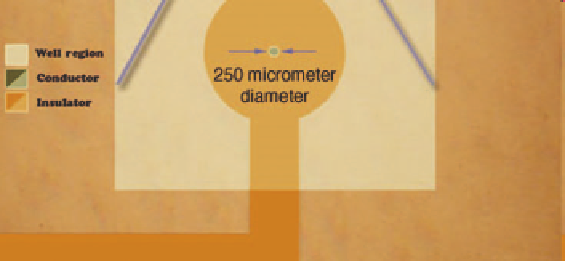Biomedical Engineering Reference
In-Depth Information
5.2.2 Electric Impedance Sensing of the Cell-Substrate
Interaction
The general approach used in this methodology was introduced in Chapter 1.
In this case, instead of the placement of a vibrating electrode in the vicinity of
cells, the latter can be deposited on a substrate where a very small electrode is
surrounded by a larger electrode structure (Figure 5.3). Impedance spec-
troscopic measurements can then be performed at variable frequencies.
Such a structure, excited at 4KHz frequency, was designed by Ivar Giaever,
Nobel Laureate in Physics, who now works in biophysics. The key for such
measurements is the dimension of the working electrode. Unless the electrode is
extremely small, the impedance of the culture medium, in series with impedance
of the electrodes, will dominate the measurement. The constriction resistance of
the solution is directly proportional to the resistivity and inversely proportional to
the diameter of the electrode. This can be overcome by the electrolyte-electrode
interface which is inversely proportional to the square of electrode diameter. If
the electrode diameter is 10
3
cm and the frequency is chosen at around 4 kHz,
the Faradaic resistance is several times larger than the constriction resistance. In
this way, the activity of the cells anchored to the electrode can be revealed. If two
large electrodes had been used instead, the solution resistance would have
concealed the signals. The principle at the core of this method is illustrated in
Figure 5.4.
5
The electric cell-substrate impedance sensing system (ECIS) is
commercially available and currently used in applications such as study of
attachment and spreading of living cells, cellular growth and proliferation,
angiogenesis, wound healing, cell migration, etc.
6-14
d
n
4
t
3
n
g
|
2
n
3
.
5.2.3 Miniaturization of the Electrical Impedance Tomography
Technique
In the electric impedance technique, if the electrodes are arranged radially
around the cell, impedance measurements can be used to map the membrane
Figure 5.3
Impedance spectroscopy: electrodes set up for measuring the metabolism
of living cells attached to the substrate.
5
(Reprinted by kind permission of Nature Publishing Group.)

